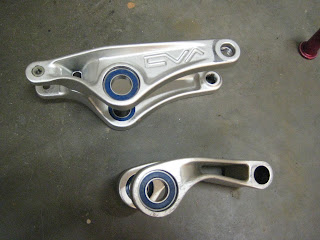As I mentioned in a previous post, I have a new downhill bike. I wanted a bike that fit a bit better (longer reach) than the Big Hit. As is usually the case, there wasn't a bike available to me to test ride, so I had to surf the forums and compare manufacturer's stats to pick the new bike. The winner is...a
Santa Cruz V-10.
Those are very expensive so I had to browse the used market until I found one that was a few years old but didn't look abused. I found a 2007 V-10 that appeared to fit the bill. After some lengthy email exchanges, I was the proud owner of my very own V-10. Here's what it looked like when I built it up after it arrived from its previous owner in New York.

There were a few problems with the bike that needed to be addressed right away. It needed new cranks, a new rear derailleur, new wheels, a new rear shock and the fork was leaking oil. Some of that was known at purchase time, others were surprises after the fact. Oh well, that's to be expected when you can't test ride it before buying.
I called Fox and got some new seals and an extra firm spring for the Fox 40. I completely dismantled the fork and installed the new spring and seals. Here's an exploded view of the fork just before
reassembly.

After consulting
PUSH Industries, I called
Go-Ride and ordered a new 2010 Fox Van R shock. I had Go-Ride send it directly to PUSH for custom tuning. I also picked up a new
SRAM X.9 rear derailleur,
Mavic 823
UST rims, and
Maxxis Minion 26x2.5
UST tires.
On the used market, I grabbed a
Truvativ Howitzer
XR bottom bracket,
Truvativ Holzfeller-OCT
Crankset, Crank Brothers 50/50 XX pedals, and a Hadley 150x12 rear hub to match the Hadley front hub I already owned.
Today I picked up the rebuilt wheels from my trusted local mechanic/wheel builder and got the bike put together in its final state. Here are some beauty shots.


With the addition of the rebuilt wheels, I've now completed all upgrades planned for this bike. It took a couple of months to get to this point and I've taken it to
Snowshoe twice already this year. The next trip is coming up in a few weeks.
With the bike fully built and running smoothly, the question remains, does it fit better than its predecessor? Well, it's about the same reach as before - maybe slightly less. However, there are some benefits to the new bike. Most significantly is the weight. The Big Hit was about 55-56 lbs. The V-10 is about 46 lbs. For the most part, weight isn't a big deal with a downhill bike. A heavier bike is more burly and, like me, has more mass for gravity to pull it down the mountain. Where I do notice the weight loss is when jumping the bike. This bike gets scary high. Way more air than I can handle right now. I'm still learning how to deal with that.
So, had I known then what I know now, would I have purchased the V-10? Probably not. It's an excellent bike, but I don't think I gained any reach with this purchase. I might have been better off had I held on to the Big Hit a little longer and purchased either an extra large 2010
EVIL Revolt or an extra large 2010
Turner DHR. However, since those frames alone cost almost as much as I have invested in the V-10, I'm not sure when I would have been able to afford one of those. I'm sure I'll post again when one of those frames arrives on my doorstep. Stay tuned. ;)


















